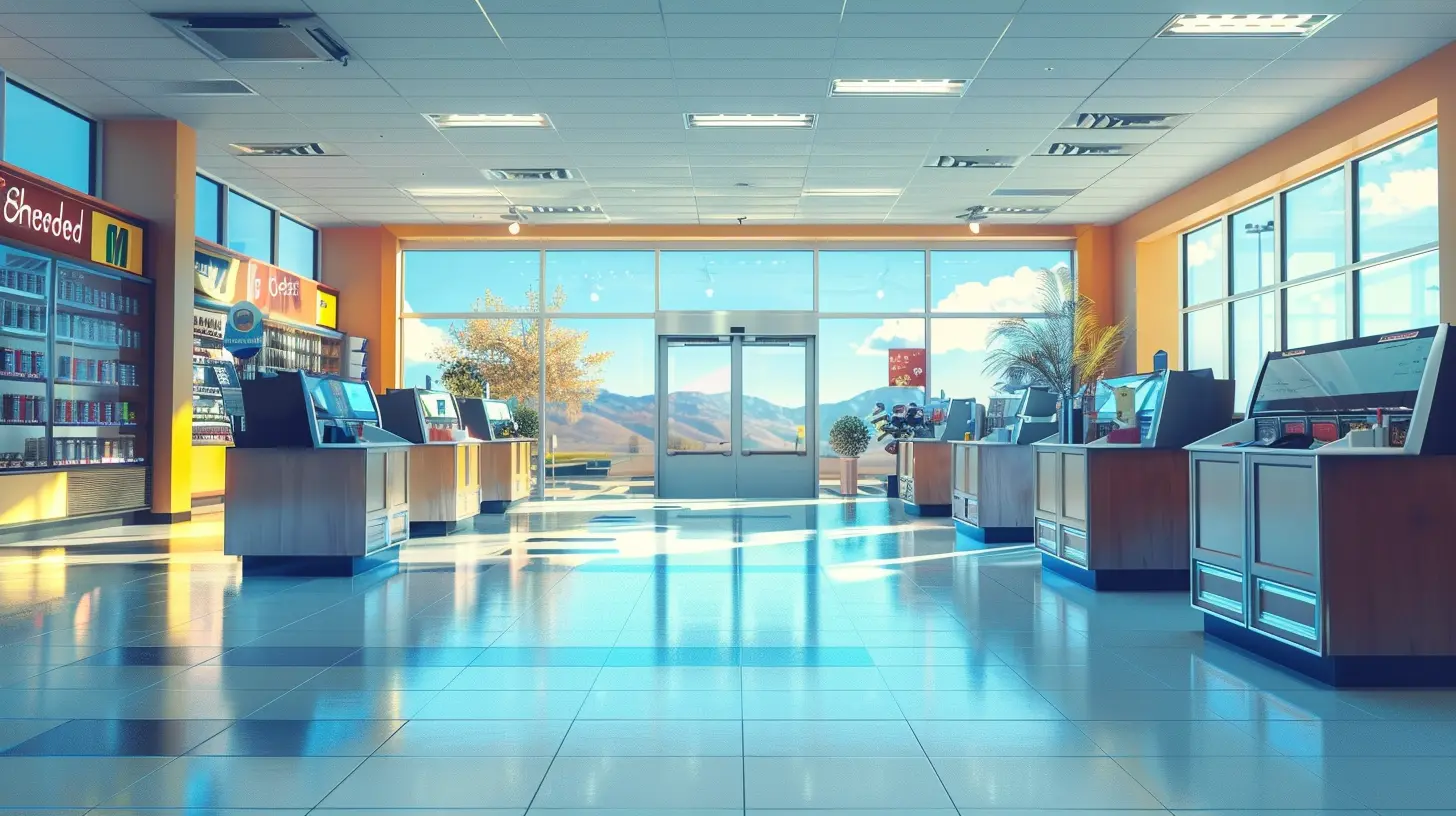Cash Flow Management Tips for Brick-and-Mortar Stores
7 December 2024
Running a brick-and-mortar store is no walk in the park, right? Between inventory purchases, rent, payroll, and all those unexpected expenses that seem to pop up out of nowhere (hello, leaky roof!), managing cash flow can feel like juggling flaming torches while riding a unicycle. But here's the good news: with the right strategies in place, you can get a handle on your cash flow, keep your business thriving, and maybe even enjoy a little peace of mind. Let’s dive into some actionable cash flow management tips tailored specifically for brick-and-mortar stores like yours.
Why Cash Flow Management is the Lifeblood of Your Business
Think of cash flow as the pulse of your business. It’s the movement of money in and out of your store—how much cash is coming in from sales and how much is going out to cover expenses. When your cash flow is positive, you’re bringing in more money than you’re spending (yay!). If it’s negative, well… that’s when the sweaty palms start.Here’s the deal: Poor cash flow management is one of the leading reasons small businesses fail. But don’t worry—we’re not here to dwell on scary statistics. We’re here to make sure your store is a glowing success. So, let’s break it all down and give you the tools to succeed.
1. Track Your Cash Flow Like a Pro
First things first: You can’t manage what you don’t measure. If you’re not already tracking your cash flow, it’s time to start. Use a simple spreadsheet or, better yet, invest in accounting software like QuickBooks or Xero to keep tabs on your inflows and outflows.What should you track? Here’s a quick checklist:
- Sales revenue
- Fixed expenses (like rent and utilities)
- Variable expenses (like inventory and staffing costs)
- Debt payments (loans, credit cards, etc.)
- Seasonal fluctuations (because we all know summer might be booming, but January could be a ghost town)
By tracking every dollar that moves through your business, you’ll get a clear picture of your cash flow trends—and you’ll be able to spot issues before they become full-blown headaches.
2. Embrace the Power of a Cash Reserve
Let me ask you this: If sales took a nosedive for a couple of months, could your store survive? Having a cash reserve is like having a financial safety net—it cushions your business during tough times.Aim to save at least three to six months’ worth of operating expenses in a separate account. Think of it as your business’s rainy-day fund. It might take some time to build up, but trust me, you’ll sleep better knowing it’s there.
3. Cut Expenses Without Sacrificing Quality
Here’s a little secret: Trimming the fat doesn’t mean cutting corners. Take a close look at your store’s expenses and figure out where you can save without affecting the quality of your customer experience.For example:
- Negotiate with vendors: If you’ve been buying inventory from the same supplier for years, ask for a bulk discount or better terms. Loyalty can work in your favor.
- Go green: Switching to energy-efficient lighting can lower your utility bills. Bonus? It’s good for the planet too.
- Revisit your subscriptions: Are you paying for software or services you barely use? Cancel them and put that money to better use.
You’d be surprised how small changes can add up to significant savings.
4. Optimize Inventory Management
Inventory can be a tricky beast. Too much of it, and you’re tying up your cash in unsold products (not to mention needing more storage space). Too little, and you risk running out of stock and disappointing customers.Here’s how to strike the right balance:
- Track sales trends: Use historical sales data to predict demand and adjust your orders accordingly.
- Use the 80/20 rule: Focus on the 20% of products that generate 80% of your sales. Keep those in stock while cutting back on slow movers.
- Implement just-in-time inventory: Order inventory only when needed to minimize carrying costs. But be cautious—you don’t want to run out of your bestsellers.
When your inventory is optimized, your cash flow improves. It’s a win-win.
5. Offer Discounts Strategically (Without Killing Your Margins)
Who doesn’t love a good sale? Discounts can be a powerful tool for attracting customers and turning slow-moving inventory into cash. But there’s a fine line: Go overboard, and you’ll start eating into your profit margins.Here’s how to do it right:
- Bundle products: Pair slow-selling items with popular products to move inventory without slashing prices.
- Flash sales: Create a sense of urgency with limited-time offers that encourage customers to buy now.
- Loyalty rewards: Offer discounts to repeat customers. It’s a great way to keep them coming back while boosting cash flow.
The key is to use discounts as a strategic tool, not a crutch.
6. Speed Up Accounts Receivable
If you offer credit terms to customers or other businesses, slow payments can drain your cash flow faster than you can say “past due.” Here’s how you can get paid quicker:- Send invoices immediately: The sooner you bill your customers, the sooner they’re likely to pay.
- Offer early payment discounts: For example, give a small discount for payments made within 10 days.
- Follow up on overdue payments: Don’t let late payments slide. A polite reminder can go a long way.
Remember, cash sitting in someone else’s pocket isn’t doing your business any favors.
7. Consider Multiple Revenue Streams
Why rely on just one source of income when you can diversify? Adding new revenue streams can stabilize your cash flow and open up new opportunities for growth.Here are a few ideas:
- E-commerce: Expand your store’s reach by selling products online. Platforms like Shopify make it surprisingly easy.
- Workshops or events: Host in-store events to bring in extra cash and strengthen customer relationships.
- Subscription boxes: If your products lend themselves to repeat purchases, set up a subscription service for loyal customers.
Get creative! Just make sure your new revenue streams align with your brand and don’t stretch your resources too thin.
8. Plan for Seasonality
Most brick-and-mortar stores experience seasonal highs and lows. Instead of dreading the slow months, plan for them.For example, let’s say your store is busy during the holidays but quiet in January. Use the busy months to stash away extra cash. During the lull, focus on things like improving your store layout, training staff, or ramping up marketing efforts to bring in more customers.
By planning ahead, you’ll keep your cash flow steady all year long.
9. Leverage Technology to Your Advantage
We live in the age of technology, so why not use it to make cash flow management a breeze? Here are a few tools to consider:- Point-of-sale (POS) systems: Modern POS systems like Square or Toast can help you track sales, inventory, and even customer data in real time.
- Accounting software: Automate bookkeeping tasks and monitor your cash flow with tools like Wave or FreshBooks.
- Budgeting apps: Use apps like Mint or YNAB (You Need a Budget) to keep track of your expenses.
The right tech tools can save you time and help you make smarter financial decisions.
10. Don’t Be Afraid to Seek Help
Look, nobody said you have to do this all alone. If you’re feeling overwhelmed by cash flow management, consider reaching out to a financial advisor or business coach. They can provide expert advice and help you create a solid strategy for success.Sometimes, a fresh pair of eyes can spot opportunities or challenges you might have missed.
Final Thoughts
Managing cash flow for a brick-and-mortar store can be challenging, but it’s far from impossible. By staying proactive, keeping a close eye on your finances, and using the tips we’ve outlined here, you’ll be better equipped to handle whatever comes your way.Remember, it’s not about perfection—it’s about progress. Small, consistent changes can make a big difference over time. So roll up your sleeves, take control of your cash flow, and watch your business flourish.
all images in this post were generated using AI tools
Category:
Cash Flow ManagementAuthor:

Audrey Bellamy
Discussion
rate this article
19 comments
Troy Frye
Mastering cash flow is the heartbeat of your business! With these tips, you’ll strengthen your store's foundation and pave the way for lasting success. Keep pushing forward!
February 9, 2025 at 3:39 AM

Audrey Bellamy
Thank you! Absolutely, a strong cash flow is crucial for sustainable growth. I'm glad you found the tips helpful!
Norah McGinn
Great tips for enhancing cash flow! Essential for thriving in retail's competitive landscape.
February 5, 2025 at 4:40 AM

Audrey Bellamy
Thank you! I'm glad you found the tips helpful for navigating the retail landscape.
Harper Bowers
Who needs cash flow? Just sprinkle some fairy dust!
February 2, 2025 at 9:48 PM

Audrey Bellamy
While fairy dust sounds magical, effective cash flow management is essential for sustainable success in any business.
Ulrich Murphy
Cash flow management for brick-and-mortar stores? It’s like trying to keep a pet goldfish alive—just when you think you’ve got it figured out, they start doing backflips. Stick to these tips, and your cash might just swim smoothly!
January 31, 2025 at 11:46 AM

Audrey Bellamy
Thanks for the clever analogy! Managing cash flow can indeed feel that way, but with the right strategies, we can keep it swimming smoothly. Glad you found the tips helpful!
Izaak Patel
Keep your cash flowing like a happy river—no dam signs allowed!
January 27, 2025 at 12:45 PM

Audrey Bellamy
Absolutely! A steady cash flow is essential for thriving businesses. Let's keep those financial barriers at bay!
Marcus Mullen
Managing cash flow in a brick-and-mortar store is like baking a perfect cake—mix the right ingredients, keep an eye on the oven, and don’t forget to taste along the way! With these tips, you’ll be serving up profits instead of just crumbs. Let’s sprinkle some financial magic on those sales!
January 24, 2025 at 5:50 AM

Audrey Bellamy
Thank you for the creative analogy! Just like baking, effective cash flow management requires the right mix of strategies and constant monitoring to achieve sweet success.
Morgan Cannon
Great insights on cash flow management! It's fascinating how traditional retail can adapt modern strategies to enhance financial health. I’m curious about the role of technology in streamlining these processes for brick-and-mortar stores. Looking forward to more tips!
January 21, 2025 at 4:50 AM

Audrey Bellamy
Thank you for your comment! Technology indeed plays a crucial role in optimizing cash flow for retail stores. From inventory management systems to mobile payment solutions, leveraging these tools can significantly enhance financial efficiency. Stay tuned for more insights!
Seraphine Reynolds
Effective cash flow management is the lifeblood of retail; it transforms uncertainty into opportunity.
January 18, 2025 at 5:20 AM

Audrey Bellamy
Absolutely! Effective cash flow management not only ensures stability but also empowers retailers to seize new opportunities in a competitive market. Thank you for your insight!
Azurael Butler
In the heart of commerce, where dreams align, Cash flows like rivers, through thrift and design. Master the ebb, let profits entwine— Steady the course, let your fortunes shine.
January 11, 2025 at 4:10 AM

Audrey Bellamy
Thank you for your poetic take! Managing cash flow is indeed crucial for turning dreams into reality in retail. Your words beautifully capture the essence of strategic financial planning.
Esme Clayton
This article provides valuable insights into cash flow management for brick-and-mortar stores. I appreciate the practical tips offered, especially the emphasis on monitoring expenses and optimizing inventory. It’s a reminder that attention to cash flow can significantly impact a store's sustainability and growth in today’s competitive landscape.
January 7, 2025 at 12:14 PM

Audrey Bellamy
Thank you for your kind words! I'm glad you found the tips helpful for enhancing cash flow and supporting sustainability in brick-and-mortar stores.
Solenne Taylor
Effective cash flow management ensures stability; prioritize tracking expenses, optimizing inventory, and enhancing customer payments.
December 30, 2024 at 10:00 PM

Audrey Bellamy
Thank you for your insightful comment! Effective cash flow management is indeed crucial for stability in brick-and-mortar stores.
Sadie McLanahan
Thank you for this insightful article on cash flow management for brick-and-mortar stores. Your tips are practical and relevant, especially in today’s retail landscape. I appreciate the focus on strategic budgeting and inventory control. Looking forward to implementing these strategies for better financial health!
December 25, 2024 at 2:00 PM

Audrey Bellamy
Thank you for your kind words! I'm glad you found the tips helpful. Wishing you success in implementing these strategies!
Rex Wilcox
Great tips for enhancing cash flow in brick-and-mortar stores! Effective management is key to success—implementing these strategies will surely lead to financial growth and stability. Keep it up!
December 22, 2024 at 4:47 AM

Audrey Bellamy
Thank you! I'm glad you found the tips helpful. Effective management is indeed crucial for financial stability. Your support means a lot!
Genevieve Love
Essential tips for optimizing cash flow in retail businesses!
December 18, 2024 at 8:37 PM

Audrey Bellamy
Thank you for your interest! Key tips include maintaining accurate inventory levels, analyzing sales trends, managing supplier terms, and monitoring expenses closely.
Peregrine Phillips
Great article! Cash flow management is crucial for brick-and-mortar businesses. I appreciate the practical tips shared here—I'll definitely implement a few in my store. Thank you!
December 16, 2024 at 6:02 AM

Audrey Bellamy
Thank you for your kind words! I'm glad you found the tips helpful—best of luck implementing them in your store!
Thaddeus Sharpe
Great insights on cash flow management! These practical tips are essential for brick-and-mortar stores to navigate financial challenges and ensure long-term sustainability. Thank you for sharing!
December 13, 2024 at 1:42 PM

Audrey Bellamy
Thank you for your kind words! I'm glad you found the tips helpful for navigating financial challenges. Your support means a lot!
Zarev Benson
Mastering cash flow is the lifeblood of your brick-and-mortar business! Implement these tips to strengthen your financial foundation, empower growth, and ensure resilience in any economic climate. Success awaits!
December 11, 2024 at 5:34 AM

Audrey Bellamy
Thank you for your insight! Mastering cash flow is indeed crucial for sustaining and growing brick-and-mortar businesses. Your encouragement to implement effective strategies resonates well!
Alyssa Scott
Managing cash flow for your brick-and-mortar store? Think of it like a dance—if you don’t keep in step, you might just step on your profits! Here’s how to waltz through those financial challenges with grace!
December 9, 2024 at 4:59 AM

Audrey Bellamy
Thank you for the creative analogy! Keeping in sync with cash flow is indeed essential for maintaining profitability. Your insights will surely help retailers navigate financial challenges smoothly!
Thalwen Mendez
Great insights on cash flow management for brick-and-mortar stores! Implementing regular financial reviews and utilizing a robust accounting system can significantly improve cash flow visibility. Additionally, considering seasonal trends in inventory purchasing could help balance expenses and revenues more effectively. Thanks for sharing these practical tips!
December 7, 2024 at 7:29 PM

Audrey Bellamy
Thank you for your feedback! I'm glad you found the tips helpful. Regular reviews and inventory management are key to maintaining healthy cash flow.
MORE POSTS

How to Diversify Income Streams in Retirement

How to Harness Stock Buybacks to Your Advantage

Balancing Growth with Stability in Your Retirement Portfolio

How to Adjust Your Emergency Fund Strategy for Freelancers

The Connection Between Cash Flow and Profit: What to Watch For

From Financial Survival to Financial Thriving: Shifting Your Mindset

How Financial Literacy Can Transform Your Wellbeing

Gold as a Tool for Wealth Preservation: What You Should Know

Emergency Fund for Retirees: Best Practices for Security

The Role of Credit in Managing Business Cash Flow

The Role of Nonprofit Credit Counseling Organizations

How Food Prices Impact the Cost of Living